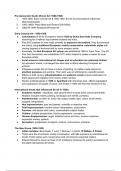Pre-democratic South African Art (1960-1994)
1. 1850-1950: Early Colonial Art & 1900-1950: SA Art and International influences.
(Non-Examinable)
2. 1950-1960s: Polly Street and Rorke's Drift Artists
3. 1960/70-1994: Resistance/Protest Art
Early Colonial Art - 1850-1950:
● Colonisation of SA by Europeans started 1652 by Dutch East India Company,
searching for a halfway stop between Holland and India.
● First SA European art was made primarily by explorers and settlers. They documented
the colony using traditional European, mostly conservative, naturalistic styles with
varying degrees of technical skill by some amateur artists.
● Eventually, the first European Art school was established 1864 in Cape Town. The SA
Fine Arts Association was established 1871 which helped to create a market for local
European artists.
● Local access to international art images and art education are extremely limited.
Art education limited, a privileged few were able to afford attending European art
schools.
● Indigenous people did not have a culture of painting, but rather made objects for
practical purposes and worship. Their work was not attributed to a specific person.
● Effects of 20th century industrialisation and endemic racism ensured dislocation of
black people and migration from rural to urban centres.
● Racism institutionalised in 1948 as Apartheid with draconian laws, official segregation
and suppression of people of colour, and ended in 1994 with first free elections in SA.
International trends that influenced SA art in 1930s
● Academic realism: naturalistic, dark ground which include Dutch school and British
Realism (includes history painting, landscape and still life, portraits).
● Impressionism: un plein air, every day subject matter, light, colour, brush marks,
cropped compositions.
● Neo impressionism: dots and dashes, scientific or objective view.
● Post Impressionism: emotive colour interpretation, cloisonnism.
● Fauvism: wild beasts with colour, unremarkable subject matter.
● Cubism: multiple perspectives, blocky appearance, conceptual.
● German Expressionism: angst, distorted colour and form, emotive response,
expresses anxiety, political.
● Surrealism: juxtaposition of objects, dreams, unconscious, irrational.
The New Group (1938-1953)
● Initial members: Boonzaaier, F Lock, T McCaw, L Lipshitz, W Battiss, A Preller
● There were few art schools, mostly conservative, with little exposure to international art
trends. Public tastes were conservative and commissions expected realism.
● Edward Roworth’s power as head of Art institutions hindered the public's acceptance of
the latest international art trends.
, ● The New Group established “Kick against junk” - anti academic realism.
● Styles: Anglicised Impressionism, Post-Impressionism but not Fauvism, Cubism,
Surrealism or Futurism.
● Later members: Ruth Everard Haden, M Sumner, C Higgs, M Laubser, J Welz, W
Hendrikz, M Kottler, G Sekoto.
Rise of Black Consciousness in SA Art
● This was a movement that emerged in the 1950s with a socio-political identity that
emphasised a heightened awareness and pride of black identity, culture and religion,
an awakening of self-worth.
Early South African artists:
● The emerging black voice in SA art occurred due to a political situation that had been
developing in the 1940s.
● During Apartheid various religious groups helped to keep arts and crafts alive by
providing basic training to black people who had no opportunity, little education and no
artistic training.
● Some art centres were in rural areas, such as Rorke’s Drift in KZN, some in cities such
as Polly Street in Johannesburg and the Community Art Project in Cape Town.
● Many artists, forced to live away from their place of birth, meant that they had lost their
cultural traditions. A naive and expressionist technique was inevitable and was used
to reflect their present circumstances.
Polly Street: Urban Art Centre in Johannesburg (1949-1960):
● Missionary activities influenced many artists to illustrate biblical themes to make
Christian values acceptable to black populations.
● Polly Street was established as a cultural centre, largely musical and literary space for
black people living in urban areas.
● Cecil Skotnes, newly graduated art student from Wits University, and was appointed
cultural officer for Polly Street in 1953. Polly Street then became more focused on
introducing the fundamentals of art. Polly Street introduced students to fellow artists,
exposure to galleries, international trends as well as practical and aesthetic ideas.
● As a member of the Wits Group, Skotnes was particularly interested in work produced by
black artists. Skotnes did not want to stifle any inherent black talent by using a
Eurocentric approach.
● Despite this, Western art practices were taught such as still life, life drawing,
landscape and abstract design, usually in cheap and easily obtainable media as
resources were few. Figurative and representational art was encouraged at Polly
Street, with subject matter derived from the immediate environment.
● Skotnes was a founding member of the Amadlozi group in 1961 (Spirit of our
Fathers) which promoted the art of black artists.
● The centre was eventually closed by the enforcement of the policy of separate
development, as the government saw no point in providing cultural facilities for black
people.




